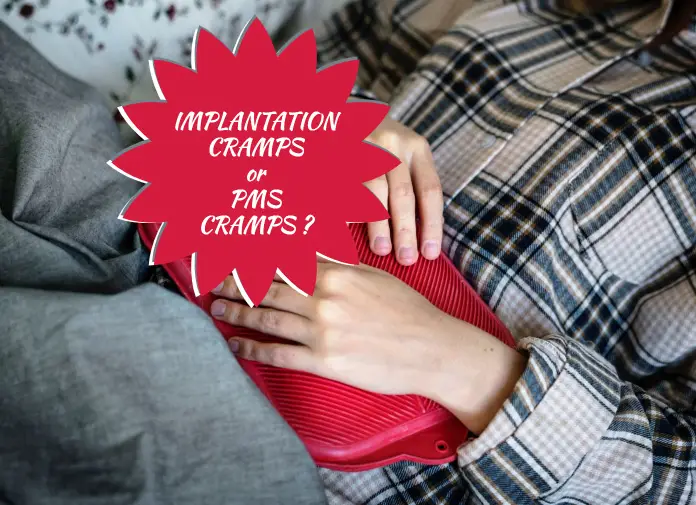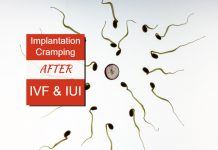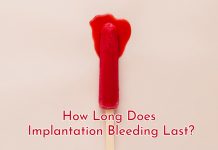Implantation Cramps or PMS Cramps is a question that bothers woman quite a lot!
Cramps happen due to so many reasons. They can happen in any part of the body. But right now the reference is to abdominal pain. Cramps are involuntary muscle shortening. You might have those painful night-time leg pain or ovulation cramping. But the worst is the case of menstrual cramping. Menstrual pain is involuntary, and they come in waves and are spasmodic. Implantation cramps are mild and short-term.
The case of menstrual cramping is easy to handle in today’s time because of OTC painkillers. Muscle relaxant and analgesics are available to treat the menstrual cramping. But during implantation, such painkillers can affect the success of the conception.
Whenever you experience such pain, it is essential to know if those are implantation cramps or PMS cramps to avoid any mishap. Not only is it a symptom but also a warning for taking precautions during implantation.

What is implantation cramping?
During implantation, the embryo invades the lining of the uterus. It creates a space for itself. Implantation begins from the first week and lasts up to 20th week of gestation. It is for the nourishment of the growing embryo.
After 20th week the embryo has a fully developed placenta, and it gets all nourishment through it. The placenta also acts a medium for removal of waste and barrier to harmful substances.
How do PMS cramps feel?
Premenstrual pain is mild and gradually increase in intensity. When there is a pain in the abdomen near your period date you know that period is about to happen.
Pre-Menstrual Syndrome (PMS) gets its name due to the set of things happening to you at the same time.
Mood swings, nausea, bloating and PMS cramps are all signs that your period is near. PMS cramping is similar to implantation cramping at early stages. Later on, PMS cramps become painful and hurt a lot.
Implantation cramps gradually stop feeling and you are at ease. Implantation cramping pain is even milder than PMS cramps. They are like tingling sensations pulling down something in your stomach. It’s actually the sinking in of the embryo towards the back wall of the uterus.
What does menstrual cramping feel?
Menstrual cramping is very painful and goes on increasing. It is a pulsating pain, and as soon it feels like it’s over it becomes even more painful.
Spasmodic throbbing and pinching pain is a symptom of menstrual pain. You feel like the uterus is trying to wring like a cloth soaked in water.
There are different explanations and comparisons about menstrual cramping. But the common conclusion is that they are extremely painful.
You can take muscle relaxant or analgesics during menses. Most women have to pop a pill every month to be able to withstand the pain.
Pain during menstruation is not like implantation pain that happens momentarily. They continue for the first two days and return by the end of the period. At the end of the period, you again have a session of cramping. It feels like the after surgery stitches or something as the post-trauma effects.
They subside or may continue after the period for a day. After that, if the pain continues, then it may be because of cysts.
If a woman had PCOS, then she might have Dysmenorrhoea pr painful menstruation. The cysts cause more discomfort as blood from the endometrial lining trickles down them.
How does implantation cramping feel?
Implantation cramps are something in between of PMS cramps and menstrual cramping. You don’t feel any impending event coming when you have implantation cramping. And the pain is nothing compared to menstrual cramps.
You will just feel that something tiny is pulling or drilling in your stomach. It will be a tingling sensation that will go away with time.
Most women never feel implantation pain because it is so mild. You might feel like you have bloating or flatulence. But gas distress pain is worse than implantation cramping sometimes.
Women have a higher tolerance for abdominal pain, and so most don’t realize implantation. If there was a way to recognize that you have implantation then may be pregnancy tests wouldn’t be such a mess.
Implantation pain can be heavier in case of abnormalities such as tubal pregnancy. In that case, implantation occurs in tubes and the narrow pathways expand. It causes pain that gets worse with time. You need to see your doctor for getting treatment as soon as possible. The later is the stage of tubal pregnancy more severe is the damage.
Implantation cramps or PMS cramps?
Few signs can help distinguish implantation cramps or PMS cramps. You can sit with a pen and paper and consider them to understand what was the bloody discharge you had.
1) Timing of cramping
Implantation pain happens near ovulation date and lasts for at most a day. PMS cramps are after two weeks from ovulation and a few days earlier than the period. Implantation cramping cannot happen after the period as the egg already passes out with the menstrual blood. Implantation occurs after 7-12 days from ovulation. PMS and implantation cramping both occur before period but differ in their proximity to the day of starting.
2) Intensity of pain
Implantation pain under normal circumstances doesn’t get severe. They will be mild until they subside entirely. PMS contractions gradually increase in intensity and eventually your menses start. During menstruation, the cramps intensify, and the pain is unbearable. Implantation cramps rarely go to touch the threshold level of the least tolerant women.
3) Frequency of cramps
The number of times you feel your stomach twisting and turning is negligible in case of implantation. During PMS the frequency or the rate of cramping increases as menses come closer. Implantation pain might not even keep occurring all the while. You will some tugging early and randomly after a while. PMS cramps are more repetitive, and the intervals get shorter. Gas distress also feels less painful sometimes and then it again pains.
4) Duration of cramping
Implantation cramps occur for a shorter duration even less than spotting. PMS spasms continue for a week throughout a period. Some women will have implantation cramping only for a few minutes or hours.
5) Kind of pain
Implantation cramps are like tingling knotting and pulling. PMS twinge are spasmodic and randomly. Sometimes you may feel that there is stretching or you are having constipation. At another point of time, you may feel that the cramping is going to tear the lower region apart.
Early signs of implantation
The earliest sign of implantation is mild cramping. Despite being a 48 hours process implantation occurs in two stages. During the first stage of implantation, there is cramping because of sinking in of egg.
The egg membrane has fibers that pierce endometrial lining and cause egg embedment. After the attachment of trophoblast fibers, the endometrial lining glands secrete substances that allow the egg to move in.
Early signs of implantation or pregnancy are nearly the same. Actually, implantation precedes early pregnancy. They are different terms for a similar thing.
What to do if you feel it is implantation instead of PMS?
You must get a home pregnancy test. Wait for five days at most to take a home pregnancy test. If you can afford more, then take a pregnancy test after three days from implantation.
After that, if you get a positive pregnancy test then consult your doctor. Get a blood pregnancy test and blood group test. Rh blood group compatibility is essential for the safety of your baby.
During implantation stay calm and eat healthy stuff. Avoid heavy workout. Do not insert tampons. Sexual intimacy during implantation can also cause problems. Over-the-counter, painkillers are not required and can interfere with the chemical makeup of the body during implantation.




![Implantation Bleeding With Twins [How long does IB last with twins?] Implantation Bleeding With Twins](https://www.pregnanteve.com/wp-content/uploads/2019/01/implantation-bleeding-with-twins-218x150.jpg)




